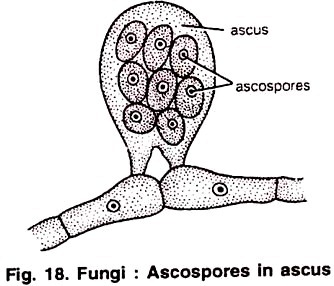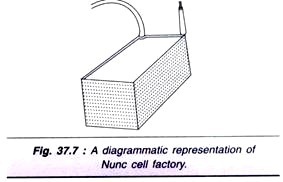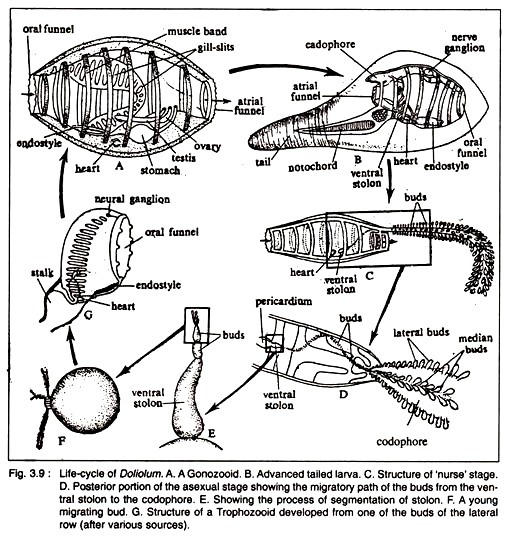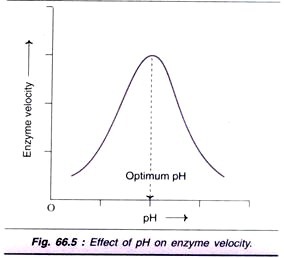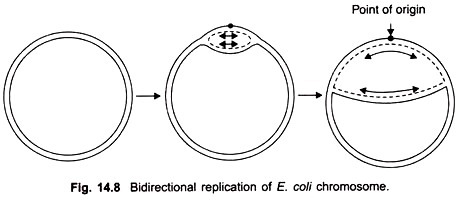Carbohydrates or Saccharides (Gr. Sakcliaron=sugar) are one of the four major classes of biomolecules.
The other three are proteins, nucleic acids & lipids. Literally, carbohydrate means ‘carbon hydrate’ or ‘hydrate of carbon’ because along with C, H and O present in equal proportion as in H2O, Carbohydrates are polyhydroxyaldehydes or polyhydroxyketones and their derivatives.
The empirical formula of carbohydrate is Cn (H2O)n or (CH2O)n where n is 3 or more.
Carbohydrates constitute 80% of dry weight of plants and 1-2% in animals. Carbohydrates are the first product of photosynthesis which serve as the major source of energy and perform structural roles. Further carbohydrates provide the carbon skeleton for most if not all organic compounds that make up the plant.
Types:
Carbohydrates are classified into four major types i.e. Monosaccharide’s, Disaccharides, Oligosaccharides and Polysaccharides.
1. Monosaccharide’s (Simple sugars):
Monosaccharides are polyhydroxyaldehydes or polyhydroxyketones containing 3-7 carbons. Monosaccharide’s are the basic units, of carbohydrate which cannot be further hydrolyzed into simpler saccharides.
On the basis of carbonyl group, monosaccharides are of two types i.e. aldoses (contain terminal aldehyde, —CHO) and ketoses (contain subterminal ketone, > C= O). Sugars with 3,4,5,6 and 7 carbon atoms are called trioses, tetroses, pentoses, hexoses and heptoses respectively.
Properties of monosaccharides:
1. All monosaccharides are colourless, crystalline, water soluble, sweet in taste and low MW organic compounds.
2. Isomerism:
Except dihydroxyacetone, all monosaccharides have asymmetric or chiral carbon atoms (carbon atoms attached to four different atoms). This allows the formation of stereoisomers or in short, isomers. Stereoisomers have the same structural formula but differ in spatial configuration. The number of possible isomers depends on the number of asymmetric carbon atoms (n) and is equal to 2n. For glucose n = 4, so there are 16 isomers. Ketoses have one less asymmetric carbon atom than do aldoses with same number of carbon atoms.
The important isomers of monosaccharide’s are as follows:
(i) D- and L-isomers:
D-sugars and L-sugars are optical isomers. In biological systems all sugars are found in D-forms. The optical activity is due to the asymmetric carbon atoms which can be able to rotate the plan of polarized light to either left (levorotatory) or right (dextrorotatory). Hence the mono saccharides are two types i.e. L-sugars and D-sugars. The D-sugars can be represented by the orientation of-OH group of asymmetric carbon farthest from aldehyde or ketone group is on right. When it is on left, it is a member of L-sugars. As the D-sugars are mirror images of L-sugars, they are called enantiomers. For example, D- and L-glycerol, D- and L- glucose, etc.
(ii) Pyranose and Furanose rings:
All sugars exist in linear o open-chain form. But in solution pentoses and nexoses cyclize into ring-forms. Ring-forms are two types, pyranose and furanose. Pyranose is 6-membered sugar ring similar to pyran with five carbon atom and one oxygen atom. While furanose is 5-membered sugar ring similar to furan with four carbon atom and one oxygen atom. The sugar rings are represented by Haworth projections. In Haworth projection (Haworth, 1928) the plane of sugar ring can be imagined as perpendicular to the plane of the paper, with the heavy line on the ring closest to the reader.
(iii) α-and β-anomers:
In a sugar ring an additional asymmetric carbon atom is created called anomeric carbon. For example, in glucose (aldose) C-l becomes anomeric and in fructose (ketose) C-2 becomes anomeric. The sugar isomers on anomeric carbon are called anomers. In α-anomer, the -OH group of anomeric carbon is written below and in β -anomer it is written above. The interconvertion of α- and β-anomers in solution is called mutarotation. In solution, glucose exist in 3 inter convertible forms- open-chain form (0.02%), α-D-fructofuranose (36%) and β- D-glucopyranose (67%).
3. Reducing nature:
All monosaccharides are reducing. Disaccharides like lactose and galactose are also reducing, except sucrose. The reducing nature is due to presence of free aldehyde or ketone group which can reduce cupric ion (Cu2+) to cuprous form (Cu+).This is the basis of Benedict’s test & Fehling’s test for sugar detection in urine.
C6H12O6 + 2Cu (OH)2—» C6H12O7 + Cu2O + H2O
Glucose Blue Gluconic acid red
In Toliens reagent (an ammonia solution), a reducing sugar reduce Ag+ of silver oxide (Ag2OT txr a metallic silver (Ag) lining in the reaction vessel.
C6H12O6 + Ag2O—> C6H12O7 + 2Ag
Silver oxide Silver
4. Glycosidic bond:
Glycosidic bond is a covalent bond formed by the condensation reaction between a sugar and the -OH group of a second compound which may or may not be the sugar. Glycosidic bonds are of two types i.e. O- glycosidic bond (-C-0- C) and N-Glycosidic bond (-C-N-C). Sugar can be joined to each other by O-glycosidic bonds to form disaccharides, oligosaccharides and polysaccharides. N-glycosidic bond formed when the anomeric carbon of a sugar liked to the nitrogen atom of an amine, as in nucleosides.
Monosaccharide derivatives:
Some important modified monosaccharide’s are as follows-
(a) Deoxyribose:
The deoxygenation of ribose at C-2 position produces deoxyribose. It is important component of deoxyribonucleotides of DNA.
(b) Phosphorylated sugars:
The transfer of phosphorylated group from ATP to -OH group of a sugar produces phosphorylated sugar, e.g. glucose-6-phosphate. The phosphorylated sugars are anionic which prevent their escape from cell and also acts as reactive intermediates.
(c) Sugar alcohol:
It is formed by reduction of aldehyde and ketone group of sugar, e.g., mannitol, glycerol, sorbitol etc. Mannitol is a sugar alcohol in brown algae, some fruits and honey. It is used as a medicine for patients with brain edema. Glycerol required in fat synthesis. Sorbitol, a sugar alcohol commercially obtained from reduction of glucose and fructose, is used in diets of diabetics because it is absorbed very slowly and metabolized after conversion to glucose, but it does not raise blood sugar.
(d) Sugar acids:
Ascorbic acid or vitamin-C is a sugar acid required for collagen synthesis. Glucouronic acid and iduronic acid are components of mucopolysaccharides.
(e) Amino sugars (hexosamines):
Glucosamine forms chitin and hyaluronic acid.
2. Disaccharides (Double sugars):
Disaccharides are composed of 2 monosaccharide’s linked by O-glycosidic bond.
The physiologically important disaccharides are:
Maltose (malt sugar) = Glucose + Glucose
Lactose (milk sugar) = Galactose + Glucose
Sucrose (cane sugar) = Glucose + Fructose
Maltose is a reducing disaccharide composed of two glucose units linked by α1,4-glycosidic bond. The reducing property of maltose is due to free aldehyde group of C-l of second glucose. Maltose is an enzymatic hydrolysis product of starch. It is formed in the germinating cereals by enzyme diastase (an amylase) and also formed during starch digestion by α-amylases of salivary and pancreatic juices.
Lactose is also a reducing disaccharide consists of galactose joined to glucose by a β 1,4 glycosidic bond. Its reducing nature is due to free aldehyde of C-l of glucose residue. Lactose present naturally in milk of mammals where its concentrations vary from 0-7%, depending on species.
Souring of milk occurs when bacteria convert lactose into lactic acid. Lactose is nutritionally important because it provides galactose which is essential for development of nervous tissue in the young ones.
Sucrose is a non-reducing disaccharide as it lacks any free reducing group in contrast to other sugars. It is commercially extracted from sugarcane and beet roots. It is the principal form of carbohydrate transported from source (leaves) to sink (site of utilization) in higher plants. Sucrose is dextrorotatory but on hydrolysis by sucrase produces a mixture of equal amount of glucose and fructose which is laevorotatory.
Cellobiose is the repeating disaccharide of cellulose in which β-glucosidic bond present.
3. Oligosaccharides:
Oligosaccharides are composed of 3-9 monosaccharide units linked by O-glycosidic bonds. They may be referred as trisaccharides, tetrasaccharides etc. When linked with proteins and lipids they form glycoproteins and glycolipids respectively.
Gentianose (glucose-glucose-glucose), raffinose (galactose-glucose-fructose) are found in some plants. Webb and Burley (1964) found that stachyose (galactose-galactose-glucose) is a transport carbohydrate in plants like Frcixinusаыепсапа, Cucurbitci pepo and Verbascum thapus.
Functions of oligosaccharides:
i. Transport form of Sugar:
Although glucose is the common transport sugar for many animals, sugars are transported in plants and other organisms as disaccharides.
ii. Storage Food:
Sucrose is the reserve storage product in sugarcane and sugar beet.
iii. Recognition Point and other Functions in Cells:
Oligosaccharides attached to cell membranes form cell coat of glycocalyx.
They are important for:
(a) Cell recognition,
(b) Cell attachment,
(c) Receptor molecules (for receiving and responding to external stimuli),
(d) Antigen specificity for human blood groups (A, B, Rh),
(e) Components of antibodies which are large molecules with attached carbohydrates,
(f) Glycoproteins of some viral coats for attaching to and invading host cell.
iv. Lactose (a disaccharide) is the natural sugar of milk.
4. Polysaccharides (Glycans):
Polysaccharides are macromolecules polysaccharides consist of at least more than ten monosaccarbohydrates. They may be linear or branched chains. Chemically, polysaccharides are of 2 types, homopolysaccharides and heteropolysaccharides. Homopolysacccharides are polymers of similar type of monosaccharides residue.
They may be glucosan or glucan (polymer of glucose) fructosan or fructan (polymer of fructose), galactosan or galactan (polymer of galactose), pentosan (polymer of pentose), hexosan (Polymer of hexoses), araban (polymer of arabinose, a pentose), xylan (polymer of xylose, a pentose) etc. Heteropolysaccharides are polymers of 2 or more type of monosaccharides residues, e.g., glycosamionoglycans (also called mucopolysaccharides), pectin, hemicelluloses etc. Heteropolysaccharide and structural polysaccharides secreted outside the cell for functioning.
Functionally, polysaccharides are of 3 types – storage, structural and mucosubstances.
(A) Structural Polysaccharides:
They are the macromolecules that perform architectural functions in plant cell wall and skeleton of animals.
Cellulose:
Cellulose is the most abundant organic compound in the biosphere. It is estimated that about 1015 kg of cellulose are synthesized and degraded annually. Cellulose is the structural polysaccharide of plant cell walls, some protists and tunic of urochordates.
Each cellulose chain is a linear glucan of about 2000-25,000 D-glucose residues joined by β1→4 glycosidic linkages. The adjacent monomers lie at an angle of 180° and the straight chain is stabilized by hydrogen bonds. The individual chain is about 1-5 mm (micrometer) long.
Nearly 100 individual cellulose chains lie side by side and bonded to each other to make a crystalline domain or micelle. About 2.0-40 micelles embedded in an amorphous matrix to form a cellulose micro fibril. Micro-fibrils are synthesized on the plasma membrane by protein complexes called particle rosettes. About 250 micro-fibrils arranged in a bigger bundle called macro-fibrils.
Vertebrates don’t have celluloses (P-amylase /β1 → 4) and therefore, can’t digest cellulose. However, the rumen (1st stomach chamber) of herbivores, gut of termites contains symbiotic microorganisms that secretes cellulase and thus can digest cellulose.
Chitin (fungal cellulose):
Chitin is the main structural polysaccharides of the exoskeletons of arthropods and also in the cell wall of most fungi and algae. Chitin is a linear polymer of N-acetyl-glucosamine (NAM) residues in/β→4 linkage. Structurally chitin is similar to cellulose. It becomes hard when impregnated with CaCO3 and proteins. Chitin is soft leathery and provides strength and elasticity.
(B) Storage Polysaccharides:
These polysaccharides serve as reserve food. At the time of need, they are hydrolyzed to release sugars available to the living cells for respiration and biosynthesis.
Followings are some important food storage polysaccharides:
(i) Dextran:
It is the storage polymer in bacteria and yeasts. Dextran is a glucosan where the glucose resides are linked by αl-6 linkage with occasional branches occur by αl-4 linkages. Dextrans are non-toxic hence used chemically as substitute of plasma proteins.
(ii) Levan:
It is the storage polysaccharides in bacteria. Levan is a fructosan composed of fructose residue joined by 2-6 linkages.
(iii) Starch (=amylum):
Starch is a mixture of glucans that synthesized as end product of photosynthesis. It is stored in form of insoluble granules (starch grains) in chloroplasts, amyloplasts and cytoplasm of plant cells. Starch grain occur singly (simple) or in groups (compound). Starch grains have characteristic shape which differs in plant species. Each starch grain has a common point called hilum surrounded layer of starch ring.
Each starch grain consists of a mixture of two type of glucans i.e. amylose (20-30%) and amylopectin (70-80%). Amylose generally found in core while amylopectin in outer part of starch grain. Amylase is a linear but coiled polymer of about 200-1000 D-glucose residues linked by α1 →4 linkages.
Amylopectin is a branched structure of at least 80 chains each with 24-30 glucose residues, inter linked byal →6 linkages. Each branch found at an interval of 24-30 glucose residues. Thus amylopectin is like a glycogen except for its lower degree of branching. Amylose gives blue-black colour with iodine solution while amylopectin gives red-violet colour.
Cooking or boiling causes swelling of amylopectin component of starch grain which ruptures the cell wall and facilitates digestion. But amylase dissolves in water and separates. Partial hydrolysis of starch produce oligosaccharides called dextrins which are water soluble. Initially larger dextrins formed called erythrodextrin which give red colour to iodine and later smaller dextrins produce called achrodextrins which give no colour with iodine.
Dextrins also produce when flour in browned or bread is toasted. However, dextrins may be found naturally in honey and plant leaves.
(iv) Inulin (Dahlia starch):
Inulin is a water soluble fructosan consists of 25-35 /β-D fructose residues joined by/β1-2 linkages. It is a storage homoglycan deposited in the form of fan-shaped crystals in root tubers of Dahlia, Dandelion, stem tubers of Chicory, bulbs of onion and garlic etc. It gives no colour in iodine. Insulin is not metabolized in human body and therefore, used for the determination of rate of glomerular filtration (GFR) in kidney. Insulin is smallest polysaccharide.
(v) Glycogen (animal starch):
Glycogen in the storage polysaccharide of animals that present in all cells but most prevalent in liver and muscles where it occurs as cytoplasmic granules usually associated with SER. It is also found in yeasts and fungi but not in green plants. In liver and muscles, excess glucose convert into glycogen by glycogenesis and during starvation glycogen hydrolyzed to release glucose by glycogenosis.
Glycogen is water soluble and gives red colour to iodine. Structurally, a glycogen molecule resembles amylopectin of starch but glycogen is more branched with branch points occur every 8-12 glucose residues. Each glycogen consists of 5000-30,000 glucose residues linked by αl-4 glycosidic bands with αl, 6-linkage of branch point.
(C) Mucosubstances:
Mucopolysaccharides (glucosaminoglycans), mucoproteins (glycoproteins) are mucosubstances forming slime, mucus or mucilaginous compounds in both plant and animal body. They have structural and protective functions. Mucopolysaccharides are heteropolysaccharides present in the matrix of cell wall and the ground substances of connective tissues in animals. They are characterized by the presence of amino sugars and uronic acids.
Some mucopolysaccharides are as follows:
(i) Hemicelluloses and Pectins:
These are heterogeneous group of polysaccharides that found in the amorphous matrix of plant cell wall. Hemicelluloses are flexible cellulose-linking glycans. They are not the modified cellulose as the name indicates. Some common hemicelluloses are xyloglucan, xylan and glucomannan.
Pectins are linear or highly branched polysaccharides that form a hydrophilic gel in which hemicellulose-cellulose network is embedded. The most common pectins are homoglactouronan (pectic acid), arabinans, arabinogalactan, rhamoglactouronan etc. Pectins of cell wall determine the hydration and orientation of cellulose microfibrils. In wood, the matrix contains lignin, a phenolic polymer.
(ii) Agar (Agar -agar):
It is a cell wall mucopolysaccharide of some red algae (Gelidium, Gracilaria). It is used in culture medium, Cosmetics, leather, laxative, baked goods, meat industry and an emulsifier in dairy products.
(iii) Carrageenin:
It is related to agar and found in red algae Chordrus crispus. It is used as a component of tooth pastes, deodorants, cosmetics etc.
(iv) Hyaluronic acid:
It is a linear polymer of 250 to 25,000 disaccharide units that composed of D- glucuronic acid and N-acetylglucosamine joined by β l → 4 linkages. It occurs in the ground substance of connective tissue, synovial fluid and vitreous humor of eye.
The other glycosaminoglycans of ground substance of connective tissue are chondroitin sulphate, dermatan sulphate and keratin sulphate. But heparin is a sulfated glycosaminoglycan present in most cells of connective tissue and acts as anti-coagulant.
(v) Peptidoglycan (Murein, Mucopeptide):
It is made of heteropolysaccharide chains cross- linked by short peptides (generally tetrapeptide). Heteropolysaccharide chains are formed of two alternate amino-sugar molecules, N-acetylglucosamine (NAG) and N-acetylmurainic acid (NAM).
(vi) Lipopolysaccharides:
It is a complex of lipid and polysaccharides which forms the outer membrane of Gram negative bacteria. Lipopolysaccharide induces fever, shock and other toxic effects.





